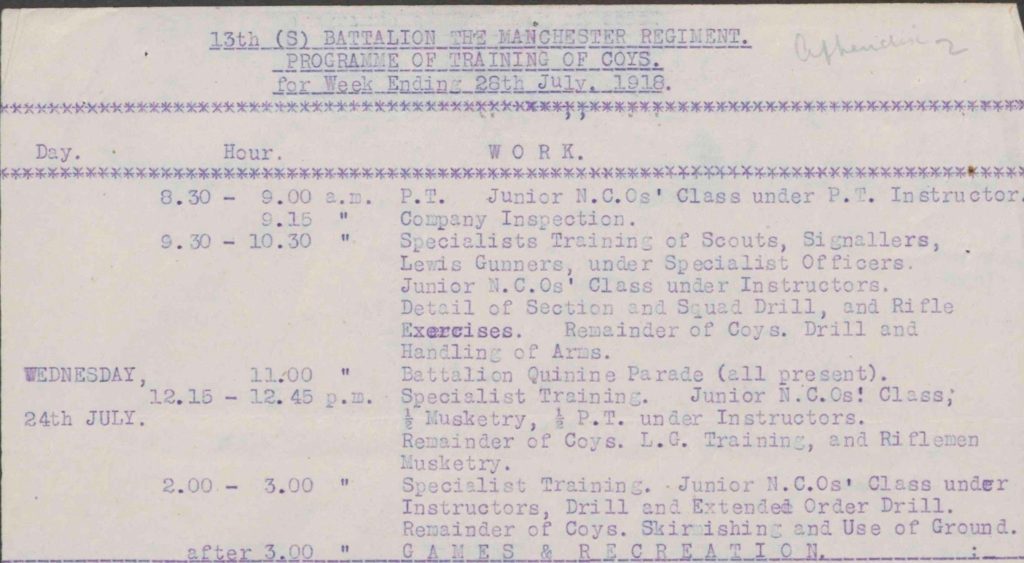Saturday July 27th, 1918
Thirteenth day defaulters. Rheumatics rather better. Still raining. No duty again. Rained hard till night when it cleared.
Training Schedule
For the last couple of weeks, the Battalion has been working to a training and fatigue schedule outlined in an Appendix to the Battalion War Diary.
The programme for today is a repeat of Wednesday, July 24th:
You will see that the Quinine Parade continues each day – for which the whole Battalion is to be present.
The junior NCO are in their own classes with a variety of instructors. Dedicated training is also being provided for Scouts, Signallers and Lewis Gunners.
Those not involved in specialist training are being instructed on ‘Skirmishing and the Use of Ground’. After 3pm the whole Battalion is to enjoy Games and Recreation – soccer is undoubtedly on the agenda.
Skirmish in WWI

Over the course of the war, the tactics of the army and its infantry changed radically. ‘Pre-war infantry tactics emphasized successive attack waves using speed and ferocity to achieve battlefield objectives.’ ² However, these tactics were very costly and often unsuccessful for the attacking force. This was due largely to the entrenched warfare of WWI with its heavy artillery and machine guns which favoured the defenders.
Therefore, by 1917, ‘all armies were replacing ridged mass infantry attack formations with smaller, more flexible columns and skirmish lines for the purposes of maneuverability and safety from enemy fire’.²
The photograph shows British troops practicing the attack at the training school at Wisques, near St Omer in August 1916.*
Skirmish Line
Consequently, both the infantry and cavalry soldiers in WWI were increasingly trained as skirmishers. As such, they would be deployed in a skirmish line for vanguard, flank guard or rearguard actions. These are more spread out and random than the more traditional line formation used in the early days of the war. They are used to delay or harass the enemy. Their open formation and smaller size keeps them agile and able to use the terrain to mask their position, and to advance or retreat more readily.¹
When Lt-Gen Ivor Maxse became the Inspector General of Training for the British Army infantry in 1918, he made these tactics more mainstream. He proposed that platoons should advance in columns with five to six yards between each soldier.² Presumably this is what Frank and the Battalion are being taught today.
13th (Service) Battalion War Diary – 27th July 1918 – Haudricourt, France
Training and working parties as yesterday. Baths opened and part of Battalion bathed. Brigade bounds published.
References & Further Reading
¹ Skirmisher on Wikipedia
² Infantry on International Encyclopedia of WWI
* Q 4157, copyright Imperial War Museums.


